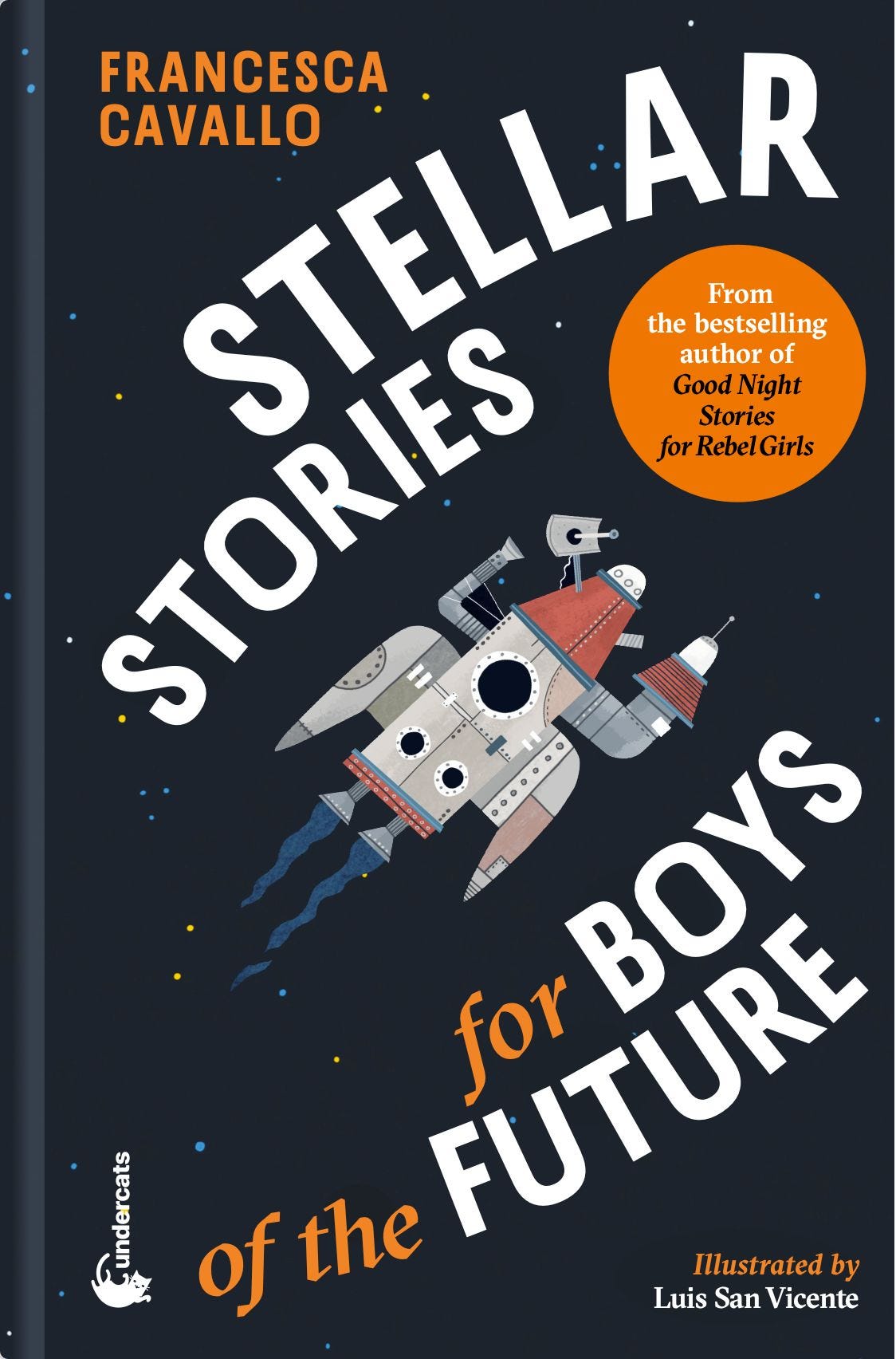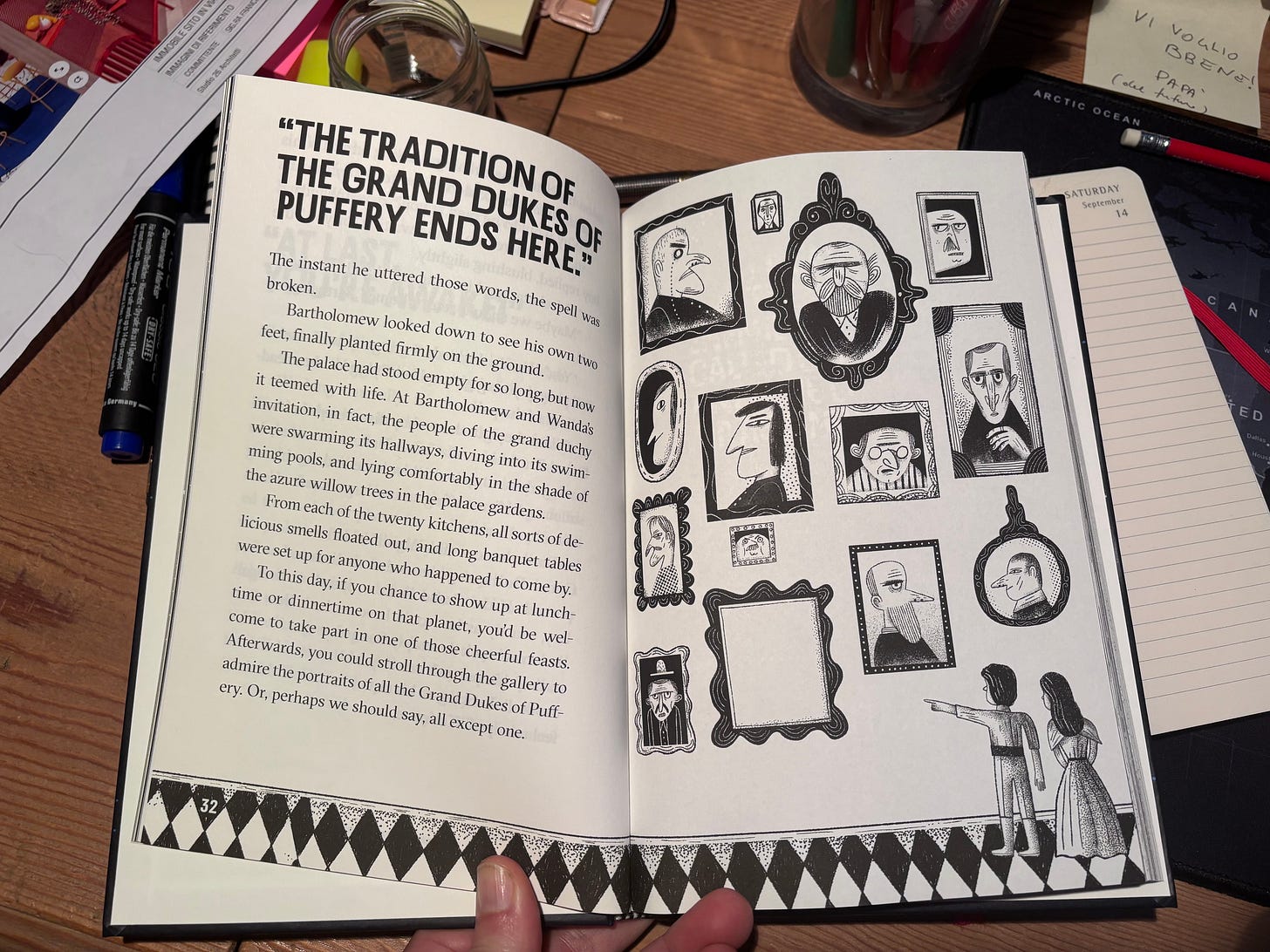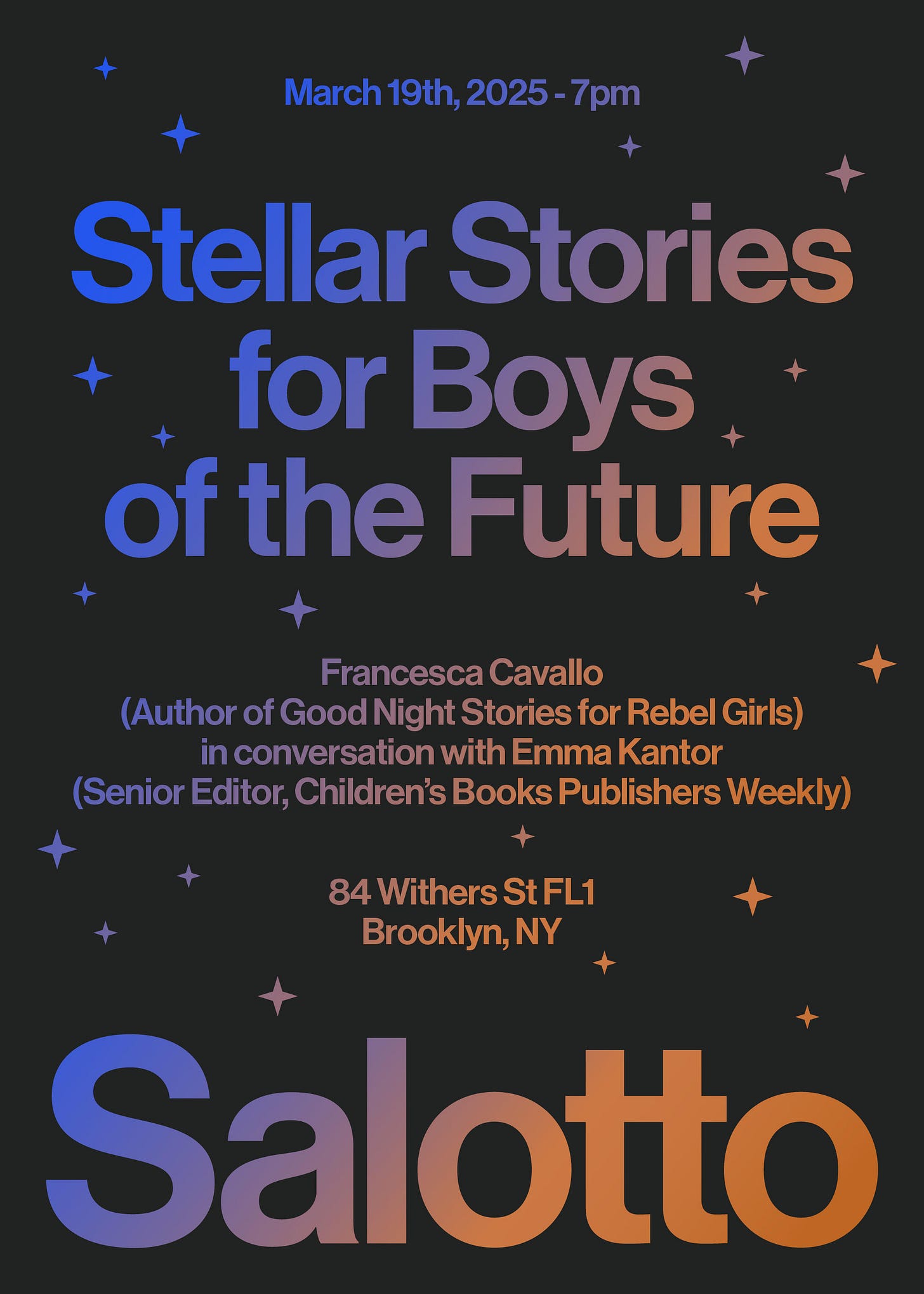Self-publishing my way through the gender wars
I could not find a space in traditional publishing to express my perspective on gender and children's books, so I created it.
Not many people know that Good Night Stories for Rebel Girls wasn’t my first book. It was my seventh. I had published the first six through a traditional publishing deal that left me sorely disappointed. The Italian publisher I worked with bought the rights for six books in bulk: four were illustrated books intended to help children cultivate a healthy relationship with fear, and the other two were my retellings of The Nutcracker and a rhymed version of Romeo and Juliet, both illustrated by the excellent Philip Giordano.
I expected the publisher to promote the books or, at the very least, ensure they were on bookstore shelves somewhere. Instead, they were nowhere to be found. Worse still, when the unsurprisingly low sales numbers arrived, we - the creators- were blamed for them.
It was an awful experience. My publisher made me feel like a failure and a disappointment. I found this deeply unfair because, at twenty-five and new to the industry, I had no levers to pull in terms of marketing or distribution. Wasn’t an established publisher better equipped than a first-time author to generate demand for the books they had chosen to publish?
I thought the problem might be the way the Italian market worked, so - since I was living in California - I tried to find an agent in the United States. As an immigrant author with no real traction in the U.S. market (and English as my second language), my chances were low. Indeed, I found no representation.
An alternative to traditional publishing
Despite the lack of recognition, I was convinced I could make books that readers would love, so I started looking for alternative ways to create and distribute them. That’s when I stumbled upon a blog post by a kid from Utah who had just raised a couple hundred thousand dollars on Kickstarter to launch a watch brand. He happened to live nearby, so we met for coffee in Palo Alto.
Even though he was selling something completely different from what I had in mind, he was an outsider like me. He had figured out how Kickstarter worked and was willing to share that knowledge.
In April 2016, Elena Favilli and I launched Good Night Stories for Rebel Girls on Kickstarter with the goal of raising $40,000 to print the first 1,000 copies. After 29 days, we’d raised $675,000 from over 13,000 backers in 75 countries, making our project the most crowdfunded book in history.
Remarkably, just a month earlier, we were the same writers no one believed in. Suddenly, the best literary agents in America were clamoring to represent us. That’s when I realized that an author’s “hotness” in the market reflects not their artistic quality but their commercial value at a given point in time. This is crucial to remember. We tend to believe agents and publishers make us “official,” but that’s a delusion. The value of our work lies in the relationship we create with our audience. Sometimes, that value aligns with commercial viability; other times, it doesn’t. Neither circumstance changes our worth as creators nor that of our peers.
A seven-figure royalty advance
We signed with CAA, and through our agent, we received a $1 million offer from one of the “Big 5” publishers to buy the rights to our book. We said no. From our perspective, we had just proven that there was enormous demand for a book like ours and that we could reach readers directly. Why would we give it to another publisher? We could hire a great editor, we knew plenty of extraordinary art directors, and we had already assembled creative teams for different kinds of editorial projects. So why would we need a publisher?
We wanted to make the book on our own terms without compromising its vision.
Our agent and the publisher who had made such a generous offer told us we were being unreasonable. After all, we had “never published a book before.” We responded that we weren’t aiming to publish books for reasonable girls.
Because of my experience with the first publisher, I did not think for a minute about the prestige of being published by a big, American publishing house. The experience we were living through, the direct contact with our readers… was way more fulfilling than the previous one, and I wanted to keep that going. I wanted to see where it would lead.
I felt signing with a traditional publisher would reign it all in, that it would bring that extraordinary adventure in a space that was known. And I wanted to go where the wild things are.
Staying true to your vision
I also felt these people didn’t truly understand what I was trying to accomplish.
Traditional publishing is relatively rigid; publishers prefer books that fit nicely into predefined categories. The problem is that I’m not well-versed in existing boxes. Sometimes I joke that I am queer from every angle, I simply don’t fit into pre-made categories. Never have.
With Rebel Girls, I wanted to create something that didn’t exist yet: a book of stories about real women written in the style of fairy tales. I didn’t simply want to “inform” children of the existence of these women; that’s what an encyclopedia is for. Bedtime stories serve a different purpose: they help kids understand themselves, to become acquainted with their inner life through the adventures on the page. Fairy tales do this through symbols that open a door to the subconscious of readers.
How could I do that in a book of biographies? I selected stories and scenes that could have symbolic value and connect with readers on a deeper level. Then, I removed all those elements (including dates!) that would separate readers from that door.
No dates in a book of biographies? Yikes.
Publishers believed we had found a clever way to celebrate “successful women.” But I was actually asking a different question: How powerful would it be if children worldwide saw themselves—shaping their understanding of their inner lives—through the lived experiences of real women?
That was a significant departure from everything else on the market. The publishers couldn’t see what I was doing, but to me, it was critical. Self-publishing was the only way to protect it. Those choices created a powerful emotional resonance with readers. Mothers told me they shed tears as they read these stories to their children, and that meant everything to me.
Crowdfunding gave us enough money and confidence to try what had been deemed impossible: We built a publishing house from scratch, complete with its own distribution network capable of selling and shipping tens of thousands of books a month worldwide.
The book did extremely well without a traditional publisher. It sold millions of copies, spent over 30 weeks on The New York Times bestseller list, and was translated into 49 languages. In April 2016, when we launched the crowdfunding campaign, our company had $8,000 left in its bank account. By December, we had made $2 million, which became $12 million in 2017 and $14 million in 2018.
It was exhilarating—and brutally hard work.
Then, at the start of 2019, Rebel Girls and I parted ways.
If you expect to go through this and feel like you are living the Instagram curated #authorslife… well, you’re in for an abrupt wake-up call. To protect your artistic freedom, you must be willing to engage in a gigantic amount of work that does not have anything to do with creative writing. You are also expected to give up the cushion that traditional publishing gives you to pretend in front of your peers that your career is going up and up and up, or that - at the very least - it’s stable.
Everything you experience is in its purest form: success and failure are felt without filters. It’s not an exercise for the faint of heart. You must do a lot of work on yourself to sustain this kind of roller coaster. The rewards are immense, as you are given an extraordinary opportunity to grow well beyond the “successful artist” rhetoric that proves so poisonous for so many.
Surviving Success
After the end of my relationship with Rebel Girls, I found myself asking what I would do next. I assumed that publishers would be chasing me, financing more or less whatever I wanted to do. Instead, I found out that publishers only wanted more books about women.
Maybe a novel or a graphic novel—anything that looked somewhat similar to what I had already done and “marketable” to precisely the same audience.
I did not want to repeat a proven formula. Publishers, meanwhile, wanted to turn me into a brand. People should be able to anticipate somewhat what I’d publish next. I, on the other hand, felt that if I really wanted to respect myself and my readers, all I could do was to keep close to my curiosity. If I wanted to grow as an artist, I needed above all to keep having an honest conversation with myself, to keep seeking.

Artistic creation as a form of exploration
Books are a way for me to explore new connections. To create spaces that didn’t exist before.
One piece of praise that made me proud was from indie bookshop owners: “When Rebel Girls came out, we had to create a new section in our store.” I am fascinated by creative work that carves out new space.
Nothing terrifies publishers more than these ventures because they demand greater effort and carry higher risk. After all, what if the space you’re trying to reveal simply isn’t there? How do we know who the audience might be?
But isn’t that precisely the power of ideas—to reshuffle communities, forge new alliances, and show us new ways to exist? Don’t we love books precisely because they open doors to dimensions we never knew existed? If we don’t allow books to do that, then what exactly are we defending by calling publishing a bastion of democracy?
A book for boys is a risky business
When I started working on Stellar Stories for Boys of the Future (preorder it here), I pitched it to a few publishers. Most tried to convince me to drop the “boys” part and make it “gender-neutral.” The fact that my project explores and reframes masculinity made it feel “unexplored” and, therefore, risky.
Indeed, talking about masculinity today is risky—especially for an author who built her reputation advocating for girls. People may wonder if I’ve switched teams or if I’m reinforcing a binary idea of gender. And haven’t I heard how “toxic” #boymoms are on social media?
Few books for boys even attempt to address gender in a way that aligns with current children’s publishing standards. Mostly, they’re about teaching boys how to manage emotions or secure consent, which stems from the notion that boys will grow into men who, by default, harm women. These kinds of books put the entire responsibility on the individual rather than also examining the societal systems involved.
This approach is akin to the early “girl power” books that told girls, “If you can dream it, you can be it,” while glossing over the very real obstacles girls face. Those books urged them to become “bosses,” to take STEM classes, and to ignore the structural biases around them.
At Rebel Girls, we did the opposite. We acknowledged that, yes, girls would face real challenges simply because they were girls. But there had been women before them who overcame these obstacles, and future girls would benefit from the obstacles they, too, would overcome.
Likewise, with Stellar Stories for Boys of the Future, I asked: What are the obstacles that boys will face because they are boys? What role does the system play in shaping boys’ lives? What is the dark side of male privilege, and what can be done to expose the fallacies of this system and make sure that boys learn that there may be an alternative?
Family’s expectations weigh more on boys’ shoulders
The first story in the book is about a boy who will inherit his family’s palace. There’s already a frame for his portrait in a gallery where all his male ancestors are on display. It is a palace with 1,000 rooms, and only four people live in it because the owners have always been the Grand Dukes of Puffery, and no one else can live there. However, the palace is sucking up the entire planet’s resources leaving the other inhabitants without water and wood. When an old woman calls out the injustice of that setup, the boy understands that what his father is doing is not right, but he doesn’t want to disappoint him, so he says nothing.
The old woman curses him and turns him into a balloon. He may reign over that palace, but he won’t be able to govern himself.
The story is about a journey the boy and his little sister make together to regain their freedom, and it’s about the way they challenge the system to find a freedom their ancestors never knew.
I could have chosen an easier path
A book that blames men for the patriarchy is easier to communicate. A book that teaches boys to behave, to be “allies” as if they had everything to lose and nothing to gain out of the fight for gender equality… is not very hard to make. Because it doesn’t challenge the status quo, it doesn’t require people to move from the front line to try and understand what the perspective is like from the other side.
It’s also the kind of book that I don’t think we need.
We need to build a new spiritual foundation, and we must learn to trust each other on a deeper level if we want to move past the current, tired iteration of the gender war.
Only through self-publishing could I find the freedom to make this journey on my own terms. Only through self-publishing could I assemble a team of extraordinary creatives (an editor, Paola Quintavalle, an art director, Francesca Zucchi, and an illustrator, Luis San Vicente) whose only job was to stay true to the mission of the book and offer you a truly alternative perspective on this issue.
I don’t know where this journey will lead me.
And I wouldn’t have it any other way.
New York, New York
A strong reason to choose self-publishing is the more personal, tighter, and more human connection with my readers. That’s why I can’t wait to meet you in person in New York! There will be two events:
For grown-ups: on March 19th at 7 p.m. I will be joined by Emma Kantor, the Senior Editor for Children’s Books at Publishers Weekly. There will be drinks and chats afterwards. RSVP here.
For families with kids: on March 22nd at 3 pm at Le Meraviglie, 108 Montague Street, Brooklyn Heights. I will do an interactive reading and a book signing.











Your story and your mission are inspiring. I must admit I haven't read any of your books (though I did just order the three-book hardcover Rebel Girls set and Boys of the Future), but I was first introduced to you when I saw Rebel Girls at a local book store. I was intrigued by the approach to storytelling and inspiration. My wife and I are hoping to start a family very soon and we're hoping to raise them to think differently and forever seek the road less paved just like their mom and dad always have.
I'm also a self-published author, and while my book hasn't garnered any success from a capitalistic standpoint, it was -- and will forever be -- important for me to stay in the realm of the self published for the same reasons you point out.
Anyway, just wanting to let you know I'm already a huge fan and I can't wait to check out these books.
This is everything I want to see happen, wow! Independent artists, successful self-publishing, and a gender-bending book for boys? Sign. Me. Up.